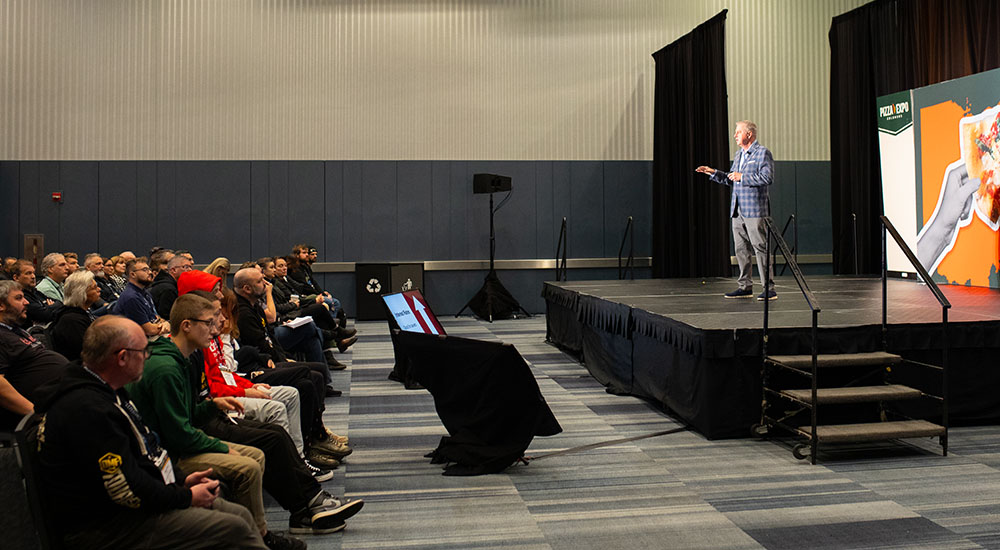As technology continues to change the way consumers interact with businesses, pizzerias should be prepared to “be where the guest is,” Donatos Pizza CEO Kevin King says during his keynote address at Pizza Expo Columbus.
Being where the guest is can mean everything from making social media “the top of the funnel” for advertising and marketing operations to ensuring your tech stack is prepared to accept online orders during the biggest football game of the year to embracing third-party delivery partners.
“Pre-COVID, we weren’t 50 percent online; we weren’t heavy into third party. But today, we’re all-in on all of those channels, because it’s where the guest is,” King says. Columbus-based Donatos has more than 450 locations across the United States, and King has spent most of his career with the operator, first working in a development role at the multi-unit pizzeria from 1990-2003, and later as president and CEO.
Social Media in the Marketing Funnel
When King first worked at Donatos, television commercials were king. “Donatos has been TV-centric since the late 80s,” he tells the Expo audience. Today, the No. 1 way to reach consumers is through their cell phones, which they are holding while sitting on the couch watching TV.
“The amount of time we spend on television today is a fraction of what it used to be. So, starting a couple of weeks ago, Donato switched from TV-first to social-first – and social is where the discussions and decisions happen live today,” he says. “YouTube views on the living room television, they’re more than any other network today. That is the power of social media, and their other views are even higher.”
Digital Sales
When McDonalds purchased Donatos in 1999 (they later sold it back to the Grote family), executives were awed that the pizzeria accepted online orders. Today, about 90 percent of sales in the Columbus market are through digital channels.
“Our system-wide average is around 80 percent now,” King says, adding that the figures for digital orders include third-party delivery apps, catering orders and the AI call center. “Our guests want to order online, and you’ve got to be there for them.”
Being prepared to handle online orders is even more important on Friday evenings – when the average pizzeria makes 25 percent of its weekly revenue, often between the hours of 5 and 7 p.m. – and on Saturdays, when pizzerias take in another 20 percent of weekly revenue.
This came to a head for Donatos on Friday, Jan. 10, when Ohio State played the University of Texas in a semi-final game with a 7 p.m. start.
“Our technology system held up. Our people system struggled a little, because everyone in Columbus wanted pizza at about 6:30, and that’s not possible, but technology stood up for us on that day with no issues,” King says.
Pizza Consistency
One of Donatos’ top priorities is that every pizza be the same, regardless of where it is ordered. So early on, founder Jim Grote opened a commissary kitchen, where dough for every Donatos pizza is produced.
“Jim made dough in a single location and shipped it out to the restaurants. That was the start,” King says. “It’s fascinating to see all these pizzas come down the line and knowing that they’re going to end up in stores all over the country.”
Donatos locations also build pizzas on scales to ensure that every pizza is made to spec. Food cost is “an added benefit,” but King says the company insists on scales so consumers get the exact same amount of sauce, cheese, pepperoni and seasonings every time.
“Building pizzas on scales is huge. Oven consistency, that’s huge. Our entire system is built around that,” he says.
Every 14-inch pepperoni pizza at Donatos is topped with 100 pieces of pepperoni, covering the pie “Columbus-style,” from edge to edge.
Technology and Automation
To take consistency one step further, Grote Co. – launched in 1972 by Donatos founder Jim Grote – has developed several machines to standardize pizza-making. The innovations include sauce applications, pepperoni slicers, topping applicators and pizza slicers. The machines are not yet standard in every Donatos location, but demonstrations have shown the automated systems can create four pizzas in the time it takes a human pizza-maker to finish one.
The company also has rolled out pizza vending machines that create pizzas to order in six minutes, sliced “party style,” as is traditional for Columbus-style (or Tavern-style) pizzas. King emphasizes that the vending machines – one is installed at the Columbus airport – aren’t offering frozen pizzas that are reheated.
“This fully automated pizza vending machine makes fresh pizza for you – right in front of your eyes. You can watch the entire process,” he says.
Third-party Delivery
While many pizzerias consider third-party delivery a revenue thief, since operators must pay a portion of sales to third-party apps such as DoorDash, Grubhub and Uber Eats, King says the apps are part of the business plan at Donatos.
“In my time in the pizza category, it is the No. 1 disruption that we have faced,” he says of the changing delivery landscape. Consumers have so much choice, “we’ve got to be a part of the third-party providers.”
King points out that while revenue in the DoorDash annual marketplace was $8 billion pre-pandemic, it now stands at $80 billion. DoorDash merchant growth appears to be stabilizing, but the number of users continues to climb.
“If you’re resistant to third party, I really challenge you,” King says, adding that $80 billion is 1.5 times the size of the entire pizza category. “We used to say, ‘I want to get in the menu drawer.’ … Your phone is the menu drawer of today. That’s what you’ve got to do in order to survive and grow.”



